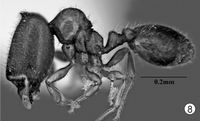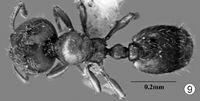Carebara terayamai
| Carebara terayamai | |
|---|---|

| |
| Scientific classification | |
| Kingdom: | Animalia |
| Phylum: | Arthropoda |
| Class: | Insecta |
| Order: | Hymenoptera |
| Family: | Formicidae |
| Subfamily: | Myrmicinae |
| Tribe: | Crematogastrini |
| Genus: | Carebara |
| Species: | C. terayamai |
| Binomial name | |
| Carebara terayamai Bharti, Akbar & Aldawood, 2014 | |
This species seems to be infrequent in occurrence. Specimens were collected by Winkler extraction method from Thanikkudy region of Periyar Tiger Reserve and Lumla region of Arunachal Pradesh. (Bharti et al. 2014)
Identification
Bharti et al. (2014) - C. terayamai is close to Carebara sauteri, however, the two species can be easily separated. In case of C. terayamai posterior margin of head is strongly concave, cephalic dorsum predominantly sculptured with longitudinal and transverse rugae present, posterodorsal corners of propodeum forming an angle not rounded, postpetiole broader than petiole, pro and mesonotal dorsum strongly convex in profile, subpetiolar process without a small blunt tubercle whilst in case of C. sauteri posterior margin of head is shallowly concave, cephalic dorsum is mostly smooth with few transverse rugae on vertex, posterodorsal corners of propodeum rounded, not forming an angle, postpetiole as broad as petiole, pro and mesonotal dorsum moderately convex in profile and subpetiolar process bearing a small blunt tubercle. The new species is also similar to Carebara dentata. However, the two species can be easily separated. In case of C. terayamai posterior margin of head is strongly concave, vertexal horns are well developed, cephalic dorsum is mostly sculptured, metanotal groove deeply impressed and body is dull, not shiny whilst in case of C. dentata posterior margin of head is weakly concave, vertexal horns are reduced, cephalic dorsum is mostly smooth, metanotal groove is less deeply impressed and body is shining. C. terayamai also shares affinities with Carebara rectidorsa but the strong sculpture over whole dorsum of head, vertex with well-developed horns and posterodorsal corner of propodeum clearly bluntly angled.
Keys including this Species
Distribution
Distribution based on Regional Taxon Lists
Oriental Region: India (type locality).
Distribution based on AntMaps
Distribution based on AntWeb specimens
Check data from AntWeb
Countries Occupied
| Number of countries occupied by this species based on AntWiki Regional Taxon Lists. In general, fewer countries occupied indicates a narrower range, while more countries indicates a more widespread species. |

|
Estimated Abundance
| Relative abundance based on number of AntMaps records per species (this species within the purple bar). Fewer records (to the left) indicates a less abundant/encountered species while more records (to the right) indicates more abundant/encountered species. |

|
Biology
Castes
Nomenclature
The following information is derived from Barry Bolton's Online Catalogue of the Ants of the World.
- terayamai. Carebara terayamai Bharti & Akbar, 2014b: 318, figs. 7-9 (s.) INDIA (Kerala, Arunachal Pradesh).
- Type-material: holotype major worker, 5 paratype major workers.
- Type-locality: holotype India: Kerala, Periyar Tiger Reserve, Thanikkudy, 9°30’N, 77°16’E, 1003 m., 15.x.2011, Winkler (S.A. Akbar); paratypes: 3 major workers with same data, 2 major workers India: Arunachal Pradesh, Lumla, 2800 m., 27.31°N, 91.43°E, 12.vi.2012 (S.A. Akbar & Jogindar Singh).
- Type-depositories: PUAC (holotype); BMNH, PUAC (paratypes).
- Status as species: Bharti, Guénard, et al. 2016: 35; Akbar & Bharti, 2017: 37 (in key).
- Distribution: India.
Description
Worker
Major. (holotype in brackets): HL 0.52-(0.55), HW 0.43-(0.46), SL 0.22-(0.26), ED 0.03-(0.04), ML 0.10-(0.15), MSL 0.40-(0.45), PW 0.21-(0.24), PTL 0.13-(0.15), PPTL 0.09-(0.12), PTW 0.06-(0.10), PPTW 0.10-(0.12), PTH 0.11-(0.13), PPTH 0.08-(0.09), HHL (0.04), CI 82-(83), SI 51-(56), EI 7-(8) (n=4).
Head longer than broad, rectangular in full face view. Occipital margin strongly concave in the middle with occipital corners almost straight, acutely rounded, lateral sides convex. Mandible with 4-teeth. Median portion of clypeus broad depressed, slightly divergent forward, anterior margin weakly concave. Antennae 9-segmented with a 2-segmented club, scapes short and clavate; reaching up to 1/3rd of posterior margin of head. Eyes with single well developed ommatidium. In profile view, vertex with a pair of well developed acute and upcurved horns. Dorsum of head convex.
Promesonotum high and roundly convex. Promesonotal suture obsolete on the dorsum. Metanotum less prominent. Metanotal groove deeply impressed. Propodeum with posterodorsal corners rounded to bluntly angled, dorsum straight and sloping down rearwards, declivity truncate to nearly straight. Petiole pedunculate anteriorly, ventral face straight. Petiole node thick with sloping anterior and posterior faces, dorsum straight to cone shaped. Postpetiole node roundly convex and lower than petiolar node. In dorsal view postpetiolar node broader than the petiolar node.
Mandibles and clypeus smooth and shiny. Head finely and longitudinally striated anteriorly and posteriorly, smooth in the middle with few longitudinal striations. Transverse striations present between vertexal horns. Mesosoma smooth and shining; lateral sides of propodeum punctuate. Petiole and postpetiole finely punctured. Gaster smooth and shining.
Head and body with abundant erect to suberect hairs. Scapes and tibiae with dense decumbent pubescence.
Body brownish in colour. Head and gaster darker than rest of body.
Type Material
Holotype (major worker) and 3 paratypes (major worker): INDIA: Kerala, Periyar tiger reserve, Thanikkudy, 9°.30`N, 77°.16`E, 1003m a.s.l., 15.x.2011, Winkler method (coll. Shahid A. Akbar). Additional 2 paratypes (major workers): INDIA: Arunachal Pradesh, Lumla, 2800 m, 27.31°N, 91.43°E, 12.vi.2012 (coll. Shahid A. Akbar & Joginder Singh). Holotype and paratype in Punjabi University Ant Collection; one paratype will be deposited in The Natural History Museum.
Etymology
The species is named after Mamoru Terayama for his contributions to ant systematics.
References
References based on Global Ant Biodiversity Informatics
- Dad J. M., S. A. Akbar, H. Bharti, and A. A. Wachkoo. 2019. Community structure and ant species diversity across select sites ofWestern Ghats, India. Acta Ecologica Sinica 39: 219–228.

